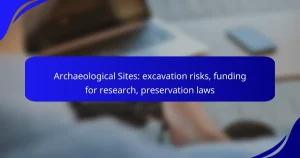Historical landmarks serve as vital connections to our past, reflecting the rich cultural heritage and diverse histories of various regions. In Australia, these landmarks encompass a wide range of types, including colonial architecture, Indigenous heritage sites, and war memorials, each contributing to the narrative of the nation's identity. By understanding the significance of these sites, we can appreciate the values and traditions they embody, fostering a deeper sense of belonging within communities.
Archaeological Sites: excavation risks, funding for research, preservation laws
Archaeological sites in Australia present unique challenges, including risks associated with excavation that can jeopardize both site safety and the integrity of findings. Funding for research relies on a mix…
Bridges: engineering marvels, historical connections, scenic routes
Bridges are not only vital for transportation but also stand as remarkable feats of engineering that connect communities and enhance scenic routes. In Australia, iconic structures like the Sydney Harbour…
Heritage Sites: urban development impacts, funding shortages, community awareness
Heritage sites in Australia face significant challenges due to urban development, which can compromise their historical integrity and cultural value. Funding shortages further exacerbate these issues, as many sites rely…
Cathedrals: visitor influx, economic benefits, community events
Cathedrals in Australia play a vital role in attracting visitors, enhancing both local and international tourism through their rich historical and architectural significance. This influx not only boosts the tourism…
Cultural Landmarks: local traditions, artistic expression, historical context
Cultural landmarks in Australia serve as vital representations of the nation’s rich heritage, showcasing local traditions and artistic expressions that define its identity. From iconic structures to Indigenous ceremonies and…
Memorials: visitor engagement, economic contributions, community pride
Memorials in Australia serve as vital connections to history and culture, enhancing visitor engagement through immersive experiences and community events. They not only boost local economies by generating tourism revenue…
Ancient Ruins: tourism revenue, local business support, cultural tourism
Ancient ruins in Australia play a vital role in boosting tourism revenue, attracting visitors from around the globe and invigorating local economies. By supporting various businesses such as restaurants, guided…
Parks: environmental threats, maintenance funding, community involvement
Parks play a crucial role in preserving biodiversity and providing recreational spaces, yet they face numerous environmental threats such as invasive species and climate change. To combat these challenges, effective…
Theatres: cultural performances, historical architecture, community engagement
Theatres in Australia are vital hubs for cultural performances, offering spaces that celebrate artistic expression and foster community engagement. With their rich historical architecture, these venues not only serve as…
Lighthouses: maritime history, navigation aid, scenic views
Lighthouses have been essential to maritime history, acting as vital navigation aids that guide vessels safely along coastlines and prevent accidents at sea. In Australia, these iconic structures not only…
What are the main types of historical landmarks in Australia?
Australia features a variety of historical landmarks that reflect its rich cultural heritage and diverse history. The main types include colonial architecture, Indigenous heritage sites, war memorials, natural landmarks, and modern historical sites.
Colonial architecture
Colonial architecture in Australia showcases the styles and building techniques brought by European settlers, primarily from the 18th and 19th centuries. Key examples include the Georgian and Victorian styles, which can be seen in cities like Sydney and Melbourne. These structures often feature ornate facades, large verandas, and intricate detailing.
When exploring colonial architecture, consider visiting sites such as the Sydney Opera House or the Royal Exhibition Building in Melbourne. These landmarks not only highlight architectural beauty but also tell stories of the era's social and cultural dynamics.
Indigenous heritage sites
Indigenous heritage sites are vital to understanding Australia's first peoples and their connection to the land. These sites include rock art, ceremonial grounds, and sacred landscapes, reflecting the rich traditions and histories of Aboriginal and Torres Strait Islander communities.
Examples include Uluru-Kata Tjuta National Park and the rock art at Kakadu National Park. Engaging with these sites often involves guided tours led by Indigenous custodians, providing deeper insights into their significance and cultural practices.
War memorials
War memorials in Australia commemorate the sacrifices made by soldiers in various conflicts, particularly World War I and II. These sites serve as places of reflection and remembrance, honoring those who served the nation.
Prominent examples include the Australian War Memorial in Canberra and the Shrine of Remembrance in Melbourne. Visiting these memorials often involves ceremonies and educational programs that highlight the impact of war on Australian society.
Natural landmarks
Natural landmarks in Australia are significant not only for their beauty but also for their historical and cultural importance. These include geological formations, national parks, and unique ecosystems that have shaped the country's identity.
Notable natural landmarks include the Great Barrier Reef and the Twelve Apostles. These sites often provide opportunities for outdoor activities, such as hiking and snorkeling, while also offering insights into the environmental history of the region.
Modern historical sites
Modern historical sites in Australia reflect the country's more recent developments and milestones. These landmarks often represent significant events, movements, or innovations that have shaped contemporary Australian society.
Examples include the Sydney Harbour Bridge and the Federation Square in Melbourne. Visiting these sites can provide a glimpse into Australia's evolving identity and its place in the global context.
How do historical landmarks contribute to cultural identity?
Historical landmarks play a vital role in shaping and expressing cultural identity by serving as tangible connections to a community's past. They embody the values, traditions, and stories that define a culture, fostering a sense of belonging and continuity among its members.
Preservation of heritage
The preservation of heritage through historical landmarks ensures that future generations can appreciate and learn from their cultural roots. This involves maintaining the physical integrity of sites, which may include restoration efforts and adherence to conservation standards. Communities often engage in preservation initiatives to protect these sites from neglect or development pressures.
For example, UNESCO World Heritage Sites receive special recognition and protection, encouraging local and national efforts to maintain their significance. Engaging with local historians and preservation societies can enhance these efforts and provide valuable resources.
Promotion of tourism
Historical landmarks significantly boost local economies by attracting tourists, which in turn promotes cultural exchange and awareness. Tourists often seek authentic experiences, and visiting these sites allows them to connect with the local culture. This influx of visitors can lead to increased revenue for local businesses, including restaurants, shops, and hotels.
Communities can capitalize on this by developing guided tours, educational programs, and events that highlight their historical significance. However, it is essential to balance tourism with preservation to avoid overwhelming these sites and diminishing their cultural value.
Community engagement
Community engagement around historical landmarks fosters a sense of ownership and pride among residents. Involving local citizens in decision-making processes regarding the use and preservation of these sites can strengthen community bonds and enhance cultural identity. Regular events, such as festivals or educational workshops, can further encourage participation and awareness.
Moreover, collaboration with schools and local organizations can promote history education and inspire younger generations to appreciate their heritage. Establishing volunteer programs for maintenance and events can also deepen community ties and ensure the ongoing relevance of these landmarks.
What are the criteria for classifying historical landmarks?
Historical landmarks are classified based on their architectural significance, cultural importance, and historical context. These criteria help determine the value and relevance of a site in preserving history and heritage.
Architectural significance
Architectural significance refers to the aesthetic, design, and engineering qualities of a structure. Landmarks that showcase unique styles, innovative construction techniques, or notable architects often receive recognition. For example, buildings designed in the Gothic, Baroque, or Modernist styles may be highlighted for their distinctive features.
When assessing architectural significance, consider factors such as the building's age, its condition, and its influence on subsequent architectural trends. Structures that have remained largely intact over time are often more highly valued.
Cultural importance
Cultural importance encompasses the role a landmark plays in the identity and traditions of a community. Sites that are associated with significant events, figures, or practices often hold deep meaning for local populations. For instance, a monument commemorating a pivotal battle or a historic theater that hosted influential performances can be deemed culturally significant.
To evaluate cultural importance, consider the landmark's connection to local customs, its representation of community values, and its role in education and tourism. Engaging with local historians or cultural organizations can provide deeper insights into a site's significance.
Historical context
Historical context involves understanding the events and circumstances surrounding a landmark's creation and use. This includes examining the social, political, and economic factors that influenced its development. Landmarks that reflect critical moments in history, such as civil rights movements or technological advancements, are often prioritized for preservation.
When analyzing historical context, look for documentation, oral histories, and other resources that provide background information. This context can enhance appreciation for the landmark and inform preservation efforts, ensuring that its story is accurately conveyed to future generations.
How can visitors experience historical landmarks in Australia?
Visitors to historical landmarks in Australia can engage through various immersive experiences that enhance their understanding and appreciation of the sites. Options include guided tours, interactive exhibits, and virtual reality experiences, each offering unique insights into Australia's rich history.
Guided tours
Guided tours are a popular way to explore historical landmarks in Australia, providing visitors with expert knowledge and context. These tours can range from small group experiences to larger organized events, often led by knowledgeable guides who share stories and facts about the site.
When choosing a guided tour, consider the duration and focus of the tour. Some may cover multiple landmarks in a day, while others offer in-depth exploration of a single site. Booking in advance is advisable, especially during peak tourist seasons.
Interactive exhibits
Interactive exhibits at historical landmarks allow visitors to engage with the past through hands-on activities and displays. These exhibits often include multimedia presentations, artifacts, and simulations that bring history to life.
Look for landmarks that feature interactive elements, such as touchscreens or augmented reality displays. These experiences can enhance learning and make history more relatable, especially for younger audiences. Check the landmark's website for information on current exhibits and any special events.
Virtual reality experiences
Virtual reality (VR) experiences offer a cutting-edge way to experience historical landmarks in Australia. Through VR technology, visitors can immerse themselves in historical events or explore sites as they were in the past, providing a unique perspective.
Many landmarks are beginning to incorporate VR into their offerings, allowing visitors to experience significant moments or view inaccessible areas. Ensure you have the necessary equipment, or check if the landmark provides VR headsets. This innovative approach can significantly enhance your visit, making history feel more immediate and engaging.
What are the preservation challenges facing historical landmarks?
Preservation challenges for historical landmarks include funding limitations, environmental threats, and urban development pressures. These factors can hinder efforts to maintain and restore sites that hold cultural and historical significance.
Funding limitations
Funding is often the most significant barrier to preserving historical landmarks. Many sites rely on government grants, private donations, or tourism revenue, which can fluctuate widely. In some cases, preservation budgets may only cover basic maintenance, leaving little for restoration or enhancement projects.
To address funding limitations, organizations can explore public-private partnerships, crowdfunding, and grant opportunities from cultural heritage organizations. Engaging the community through fundraising events can also help raise awareness and support for preservation efforts.
Environmental threats
Environmental threats such as climate change, natural disasters, and pollution pose significant risks to historical landmarks. Rising sea levels, increased rainfall, and extreme weather events can lead to structural damage and deterioration of materials. For instance, wooden structures are particularly vulnerable to moisture and pests.
Preservation efforts should include risk assessments and the implementation of protective measures, such as improved drainage systems or climate-resilient materials. Regular monitoring and maintenance can help mitigate the impact of environmental threats over time.
Urban development pressures
Urban development pressures can lead to the encroachment or demolition of historical landmarks. As cities expand, valuable sites may be sacrificed for new construction projects, often justified by economic growth arguments. This can result in the loss of cultural heritage and community identity.
To combat urban development pressures, advocacy for strong zoning laws and heritage protection regulations is essential. Engaging local communities in discussions about development plans can help ensure that historical landmarks are preserved and integrated into urban planning efforts.
What role do local governments play in landmark preservation?
Local governments play a crucial role in the preservation of historical landmarks by implementing regulations, providing funding, and facilitating community engagement. They often establish preservation ordinances and guidelines that protect significant sites from neglect or inappropriate alterations.
Regulatory Framework
Local governments create a regulatory framework that includes zoning laws and preservation ordinances to safeguard historical landmarks. These regulations dictate how properties can be modified or developed, ensuring that any changes respect the historical integrity of the site. In many cases, these rules require property owners to obtain permits before making alterations.
Funding and Grants
Local governments often provide funding and grants to support the maintenance and restoration of historical landmarks. This financial assistance can come from various sources, including local taxes, state funds, or federal programs. For example, the National Park Service offers grants for preservation projects that local governments can apply for to help maintain their historical sites.
Community Engagement
Engaging the community is essential for successful landmark preservation. Local governments often organize public meetings and workshops to gather input from residents and stakeholders about preservation efforts. This involvement fosters a sense of ownership and encourages community members to advocate for the protection of their historical landmarks.






